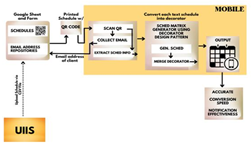A Prototype Development of a Mobile Schedule Viewer Integrating QR Code Technology and Decorator Design Pattern for Effective Dissemination of Class Schedules
DOI:
https://doi.org/10.69478/JITC2023v5n2a03Keywords:
Mobile schedule viewer, QR code technology, Decorator design pattern, Class schedulesAbstract
Class schedules undergo continuous changes with each new release, making manual scheduling a complex task. To address this issue, this study proposes integrating a mobile application that enables students to promptly access their accurate class schedules. A prototype mobile schedule viewer was developed to identify and resolve conflicts arising from conflicting schedules. The study confirmed the functionality and stability of the spreadsheet application, as the mobile schedule viewer successfully employed the decorator design pattern and integrated QR code generator plugins. These plugins facilitated the extraction of existing schedule files from the University Integrated Information System (UIIS). The overall findings indicate that the applications are 95 percent complete in terms of degree of completeness (DOC) and boast a record level of accuracy (RLA) of 95 percent.
References
R. Focardi, F. L. Luccio, H. A. Wahsheh, “Usable Security for QR Code”, Journal of Information Security and Applications, vol. 48, October 2019, https://doi.org/10.1016/j.jisa.2019.102369.
A. Magdich, Y. H. Kacem, A. Mahfoudhi, M. Kerboeuf, “A UML/MARTE-Based Design Pattern for Semipartitioned Scheduling Analysis”, in Proc. 2014 IEEE 23rd International WETICE Conference, Parma, Italy, June 23-25, 2014, pp. 300-305, https://doi.org/10.1109/WETICE.2014.9.
R. A. Oude Vrielink, E. A. Jansen, E. W. Hans, J. Hillegersberg, “Practices in Timetabling in Higher Education Institutions: A Systematic Review”, Annals of Operations Research, vol. 275, April 2019, pp. 145-160, https://doi.org/10.1007/s10479-017-2688-8.
N. M. Arratia-Martinez, C. Maya-Padron, P. A. Avila-Torres, “University Course Timetabling Problem with Professor Assignment,” Mathematical Problems in Engineering, vol. 2021, Article ID 6617177, January 2021, https://doi.org/10.1155/2021/6617177.
L. Y. Yan, G. W. H. Tan, X. M. Loh, J. J. Hew, K. B. Ooi, “QR Code and Mobile Payment: The Disruptive Forces in Retail”, Journal of Retailing and Consumer Services, vol. 58, January 2021, https://doi.org/10.1016/j.jretconser.2020.102300.
Y. G. Kim, M. S. Jun, “A Design of User Authentication System Using QR Code Identifying Method”, in Proc. 6th International Conference on Computer Sciences and Convergence Information Technology, November 29, 2011, Seogwipo, South Korea, pp. 31-35, https://ieeexplore.ieee.org/document/6316569.
B. Muthukumar, J. A. Mayan, G. Nambiar, D. Nair, “QR Code and Biometric Based Authentication System for Trains”, in Proc. International Conference on Frontiers in Materials and Smart System Technologies, April 10, 2019, Tamil Nadu, India, https://doi.org/10.1088/1757-899x/590/1/012010.
V. Chang, W. Chen, Q. A. Xu, C. Xiong, “Towards the Customers’ Intention to Use QR Codes in Mobile Payments”, Journal of Global Information Management, vol. 29, no. 6, January 2021, pp. 1-21, https://doi.org/10.4018/JGIM.20211101.oa37.
Google Workspace, “Google Sheets API Overview”, https://developers.google.com/sheets/api/guides/concepts.
A. Rahmah, P. Sukmasetya, M. S. Romadhon, A. R. Adriansyah, “Developing Distance Learning Monitoring Dashboard with Google Sheet: An Approach for Flexible and Low-Price Solution in Pandemic Era”, in Proc. 2020 International Conference on ICT for Smart Society (ICISS), Bandung, Indonesia, November 19-20, 2020, pp. 1-6, https://doi.org/10.1109/ICISS50791.2020.9307558.
D. Castro, “Google Sheet Workbook Weekly Activities”, The California State University, https://scholarworks.calstate.edu/concern/educational_resources/cc08hp38w.
J. A. Salim, A. Saraiva, “A Google Sheet Add-on for Biodiversity Data Standardization and Sharing”, Biodiversity Information Science and Standards, vol. 4, October 2020, https://doi.org/10.3897/biss.4.59228.
P. Tonella, G. Antoniol, “Object Oriented Design Pattern Inference”, in Proc. IEEE International Conference on Software Maintenance - 1999 (ICSM'99). 'Software Maintenance for Business Change' (Cat. No.99CB36360), Oxford, UK, August 30 – September 3, 1999, pp. 230-238, https://doi.org/10.1109/ICSM.1999.792619.
K. Beck, R. Crocker, G. Meszaros, J. Coplien, L. Dominick, F. Paulisch, J. Vlissides, “Industrial Experience with Design Patterns”, in Proc. IEEE 18th International Conference on Software Engineering, Berlin, Germany, March 25-30, 1996, pp. 103-114, https://doi.org/10.1109/ICSE.1996.493406.
T. O’Reilly, “What Is Web 2.0: Design Patterns and Business Models for the Next Generation of Software”, International Journal of Digital Economics, no. 65, March 2007, pp. 17-37, https://mpra.ub.uni-muenchen.de/id/eprint/4580.
J. P. Sermeno, K. A. S. Secugal, “Class Scheduling Framework Using Decorator and Façade Design Pattern”, In Proc. 2021 Second International Conference on Innovative Technology Convergence (CITC), Sibalom, Philippines, December 2021, pp. 38-45, https://doi.org/10.1109/CITC54365.2021.00015.
J. P. Sermeno, J. J. D. Orquia, “CORBA-Based Class Scheduling Framework Using Decorator and Facade Design Patterns”, Journal of Innovative Technology Convergence, vol. 3, no. 1, June 2021, pp. 9-22, https://doi.org/10.69478/JITC2021v3n1a02.

Downloads
Published
Issue
Section
Categories
License
Copyright (c) 2023 Myra Shane T. Aretaño, Abegail Christine T. Bada, Antonette B. Fabila, Wenielyn J. Sadje, Jason P. Sermeno

This work is licensed under a Creative Commons Attribution-NonCommercial 4.0 International License.



